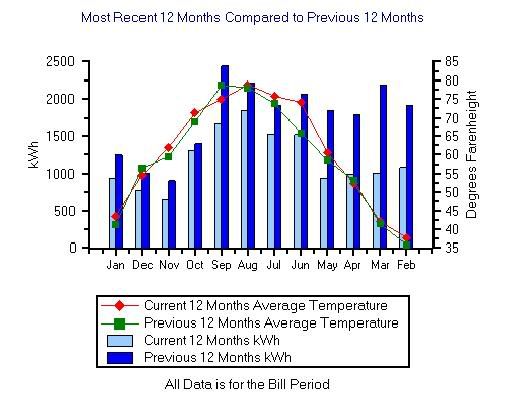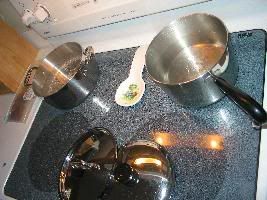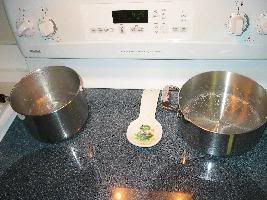Compact Fluorescent Light Bulbs Re-examined
Reviewing our electricity usage over the past year and over the past 2 years, and keeping in mind my previous discussion regarding the use of compact-fluorescent light bulbs throughout our house (see right side bar, or click http://septembersong.blogspot.com/2004_06_30_septembersong_archive.html), I’ve found a significant reduction in our monthly and daily electricity usage over time. As you can see in the raw numbers below, if you compare the Kilowatt usage averaged daily from 6/2/2004 to 1/5/2005, and compare to 6/3/2003 – 1/5/2004, you’ll see the difference. On 6/3/2003, the average temperature was low, 66F, a rather cool late Spring month – yet we used 2065 KWh or 65 KWh daily averaged. On 6/2/2004, the average temperature was higher, 74F, yet we used just 1515 KWh that month or just 54KWh averaged daily. The next month comparison, 7/2/2003 vs 7/2/2004 shows temperatures of 74F vs 76F (i.e. warmer this past year thus you’d expect again more air-conditioner use etc. thus more electricity use). Yet KWh usage is 1912 vs. 1526. The comparisons break down like this:
Compared months........ avg Temp’03vs’04....... KWh used... Avg Daily KWh use
Compared months........ avg Temp’03vs’04....... KWh used... Avg Daily KWh use
June 2003 vs 2004............... 66F vs 74F............ 2065 vs 1515........... 65 vs 54~
July 2003 vs 2004............... 74F vs 76F............. 1912 vs 1526........... 66 vs 51
August 2003 vs 2004........... 78F vs 79F............. 2213 vs 1850.......... 71 vs 58**
Sept 2003 vs 2004............... 79F vs 75F............. 2443 vs 1670........ 76 vs 56~
Oct 2003 vs 2004................. 69F vs 71F............. 1397 vs 1310........ 48 vs 44
Nov 2003 vs 2004............... 60F vs 62F.............. 904 vs 657........... 31 vs 23
Dec 2003 vs 2004................ 56F vs 55F............. 1006 vs 770......... 31 vs 23**
Jan 2004 vs 2005................ 41F vs 43F.............. 1246 vs 932......... 42 vs 31
I’ve marked with ~ those months compared where the temperature difference is 4degrees F or greater, thus allowing one to argue that the comparison is somewhat confounded. I’ve marked with ** those months where the temperature difference was within 1 degree F, thus making comparison more believable. In those ** months, you can see that the difference in average KWh usage is 8-13KWh or 18-26% less. Averaged over these 8 months compared, the difference average is 22% less Kilowatts per hour used. And furthermore, there are no months where we spent more this past 6 months than in previous 6 months periods of the same time frames.
The difference in terms of money spent?
Compared months.... billed difference.... how much less?... Percentage less?
June’03 vs ’04............. $165.05 vs $123.75......... $41.30...................... 25%
July ’03 vs ’04............. $173.03 vs $140.32........ $32.71....................... 19
August ’03 vs ’04......... $199.17 vs $168.63 .........$30.54 ......................15
Sept ’03 vs ’04............. $219.15 vs $152.90......... $66.25 ......................30
Oct ’03 vs ’04.............. $128.30 vs $121.44......... $6.86........................ 5
Nov ’03 vs ’04............. $76.88 vs $58.77........... $18.11........................ 24
Dec ’03 vs ’04............. $84.35 vs $67.68............ $16.67........................ 20
Jan ’04 vs ’05............. $103.01 vs $80.46.......... $22.55 ........................22.... avg 20%less
data compared to 2 years ago’s numbers:
June’02 vs ’04............ $146.00 vs $123.75........ $22.25....................... 15
July ’02 vs ’04............ $197.96 vs $140.32 ........$57.64 .......................29
August ’02 vs ’04....... $205.57vs $168.63......... $36.94....................... 18
Sept ’02 vs ’04 ...........$175.31vs $152.90.......... $22.41....................... 13
Oct ’02 vs ’04 ............$159.05 vs $121.44.......... $37.61....................... 24
Nov ’02 vs ’04 ...........$106.41vs $58.77............ $47.64...................... 45
Dec ’02 vs ’04 ............$119.05 vs $67.68........... $51.37 .......................43
Jan ’03 vs ’05............ $147.05 vs $80.46........... $66.59...................... 45 ....avg 29%less
Speaking cumulatively, we’ve saved $234.99 over this past 6 months as compared to the same time frame 2 years ago. Averaged, we are saving $29.37 per month compared to the previous year’s data, and saving $42.81 per month compared to 2 years ago’s data ($342.45 total). The critique in the argument might be that the temperatures are different, but if you look at the data, the temperatures differ by an average of 4% between years ’03 and ’04 month-by-month with a range of 1-11% difference, and most importantly, the temperatures are not consistently higher or lower month by month but differs randomly (additionally, the lows and highs averages are very similar year to year also). In any case the 20-29% savings is not explained by temperature differences of 4%. The other critique could be that we are behaving more frugally and thus cutting back significantly in our electricity usage. This definitely has some merit as shown in the following graph provided by my utility company:

As you can see, we have been using electricity less in the just completed past 12 months than in the previous 12 months, thus demonstrating our renewed commitment to frugality. The temperature curves overlaying also once again shows that the temperature difference is not what explains the differences. Yet the difference in the bar graphs in the 6 months prior to our changing over to compact-fluorescent bulbs is visibly MORE than in the most recent 6 months!! I can believe that we have been much more frugal this past 12 months, but were we such horrible spendthrifts in the previous year with electricity? Based on this graph, you would have to say YES! Yet we’ve also tried to save on water usage by not wasting it. In fact my wife and I are pretty reasonable people overall in terms of not wasting resources, so I’m a bit surprised at the difference that a little bit of extra care seems to have made in terms of our utility bills. In fact, when looking at our water bill over the past 6 months compared to the same 6 month time-frame years previously, I find that there is not a big difference and in fact there are more months this past year where we actually spent more water than a 6 months period a year previously (4 of 7 months) – this potentially blows a hole in the argument that we have been behaving less frugally over the past year than before in terms of utility usage.
Comparison period..................#Days................Daily Usage...........Total Usage (gal)
June 2003 vs 2004.....................30 vs 31...........146.33 vs 111.94....... 4390 vs 3470
July 2003 vs 2004......................30 vs 29............76.33 vs 100.69..........2290 vs 2920
August 2003 vs 2004..................32 vs 31...........99.06 vs 109.35...........3170 vs 3390
Sept 2003 vs 2004.......................28 vs 32...........122.86 vs 139.06........3440 vs 4450
Oct 2003 vs 2004........................30 vs 30...............127 vs 128...............3810 vs 3840
Nov 2003 vs 2004........................28 vs 32...........151.07 vs 107.19.........4230 vs 3430
Dec 2003 vs 2004........................29 vs 29...........120.34 vs 138.97........3490 vs 4030
But water usage is difficult to alter too much short of not flushing toilets and other unsanitary behaviors. And water usage may have gone up for us because our children have been growing up and requiring more baths, more dishes with eating, etc. Though this argument should go for electricity usage too. In any case, a max of $43 per month saved on electricity is nearly the cost of our cable-modem fees, and more than our local and long distance telephone bills, more than our average natural gas bill. So we have potentially saved the equivalent of this monthly averaged out over the year mostly by behaving more frugally in terms of our electricity usage. Importantly, I also began actually reading the dials on our electrical meter and calling my utility company to let them know if there was a difference so that they could come and re-read it (– I made them come by to re-read twice). This served the purpose of mainly letting whomever at the utility department and my meter man know that I’m watching the meter and their performance as well (so that they won’t try to rip me off). In general I’ve found over the past half year that the meter man reads pretty much on the money so that I could probably let that part of it go until I get a very anomalous reading.
Summation: Should you go change out all your light bulbs to compact fluorescent? I think you should, mainly because it sets you in the frame of mind to conserve as well as the potential savings of $62 over the life of the bulb versus equivalent lumens of incandescent lighting (According to http://www.newdream.org/consumer/cflfactsheet.html ). Does CF lighting definitely save you in monthly electricity bills? I would have to say it seems to in superficial analysis as above, but there are many confounds and like I said, CF bulbs sets you in the frame of mind to conserve, thus you may be conserving electricity in other ways too which would confound the comparison – being willing to tolerate more heat and cold, turning off lighting more often, using your appliances more efficiently, turning off TVs and computers more frequently, etc. These other measures in combination is probably going to surpass the savings you get directly and solely from changing out your light bulbs. So what part of the 20-29% savings we saw could be directly attributable to the change to CF light bulbs? I wished I could spout a believable figure but based on looking at the raw data and the bar-graph comparisons, I could guess that it is the low end or 20% which could be believable. Or I could guess more conservatively that it would be something like half that or maybe 10% savings, maybe even less.
Remember from my previous post on installing CF light bulbs, I spent $361.30 total to purchase all those CF bulbs for the house. It looks like I've almost saved that much in half a year through the use of CF bulbs throughout the house and (maybe) other frugal behaviors. In any case, I'd say that you could safely assume that you can make back the initial investment in compact fluorescent light bulbs within 1 year, and by 10 years (if these bulbs do last that long), I could potential have saved thousands of dollars! We'll have to see.
------------------------------------------------------------
WATER USAGE DURING THIS TIME PERIOD
Comparison period..................#Days................Daily Usage...........Total Usage (gal)
June 2003 vs 2004.....................30 vs 31...........146.33 vs 111.94....... 4390 vs 3470
July 2003 vs 2004......................30 vs 29............76.33 vs 100.69..........2290 vs 2920
August 2003 vs 2004..................32 vs 31...........99.06 vs 109.35...........3170 vs 3390
Sept 2003 vs 2004.......................28 vs 32...........122.86 vs 139.06........3440 vs 4450
Oct 2003 vs 2004........................30 vs 30...............127 vs 128...............3810 vs 3840
Nov 2003 vs 2004........................28 vs 32...........151.07 vs 107.19.........4230 vs 3430
Dec 2003 vs 2004........................29 vs 29...........120.34 vs 138.97........3490 vs 4030
But water usage is difficult to alter too much short of not flushing toilets and other unsanitary behaviors. And water usage may have gone up for us because our children have been growing up and requiring more baths, more dishes with eating, etc. Though this argument should go for electricity usage too. In any case, a max of $43 per month saved on electricity is nearly the cost of our cable-modem fees, and more than our local and long distance telephone bills, more than our average natural gas bill. So we have potentially saved the equivalent of this monthly averaged out over the year mostly by behaving more frugally in terms of our electricity usage. Importantly, I also began actually reading the dials on our electrical meter and calling my utility company to let them know if there was a difference so that they could come and re-read it (– I made them come by to re-read twice). This served the purpose of mainly letting whomever at the utility department and my meter man know that I’m watching the meter and their performance as well (so that they won’t try to rip me off). In general I’ve found over the past half year that the meter man reads pretty much on the money so that I could probably let that part of it go until I get a very anomalous reading.
Summation: Should you go change out all your light bulbs to compact fluorescent? I think you should, mainly because it sets you in the frame of mind to conserve as well as the potential savings of $62 over the life of the bulb versus equivalent lumens of incandescent lighting (According to http://www.newdream.org/consumer/cflfactsheet.html ). Does CF lighting definitely save you in monthly electricity bills? I would have to say it seems to in superficial analysis as above, but there are many confounds and like I said, CF bulbs sets you in the frame of mind to conserve, thus you may be conserving electricity in other ways too which would confound the comparison – being willing to tolerate more heat and cold, turning off lighting more often, using your appliances more efficiently, turning off TVs and computers more frequently, etc. These other measures in combination is probably going to surpass the savings you get directly and solely from changing out your light bulbs. So what part of the 20-29% savings we saw could be directly attributable to the change to CF light bulbs? I wished I could spout a believable figure but based on looking at the raw data and the bar-graph comparisons, I could guess that it is the low end or 20% which could be believable. Or I could guess more conservatively that it would be something like half that or maybe 10% savings, maybe even less.
Remember from my previous post on installing CF light bulbs, I spent $361.30 total to purchase all those CF bulbs for the house. It looks like I've almost saved that much in half a year through the use of CF bulbs throughout the house and (maybe) other frugal behaviors. In any case, I'd say that you could safely assume that you can make back the initial investment in compact fluorescent light bulbs within 1 year, and by 10 years (if these bulbs do last that long), I could potential have saved thousands of dollars! We'll have to see.
------------------------------------------------------------
LET ME GIVE AN EXAMPLE OF A NON-SAVINGS
I've heard that All-Clad pots (http://www.allclad.com/) are good because it heats food faster. This I've shown to be not true. I took an All-Clad stainless with the aluminum core 3 quart pot and a Revere 3 quart stainless steel only pot, place 6 cups of identical cold water in each, put one on an identical sized oven eye and simultaneously turned on the stove to HIGH for each eye.

The All-Clad pot took 13 minutes to boil the water. The Revere el-cheap-o pot took 10 minutes to boil the water.
Just in case one of my oven eyes were bad, I switched the pots after allowing 3 hours of cool-down time:

Again the exact same result: The All-Clad pot took me 13 minutes to boil 6 cups of cold water, the cheapo pot took me 10 minutes to boil the 6 cups of cold water. So All-Clad stainless pots take longer to heat water, I assume because of the 3-ply construction, thus taking the contained water further away from the heat. Their Cop-R-Chef collection might boil water faster, but I'd be skeptical of that too. The main proclamations by All-Clad themselves I've found is not that they heat food faster but that they heat food more evenly, thus causing less searing and burning; that they impart no metallic tastes to the fo0d; that they become heirloom-like items lasting several generations. Perhaps these are true. But can you justify $635.00 expenditure on basically 7 pots/pans with lids for 3 of them? I somehow did and purchased them, but I think this is an example of affluenza without any obvious evident benefit except for the Luxury quotient.